As we wrap up the first five months of 2024, there is a glimmer of hope on the horizon. Americans' financial stress levels have shown a slight but significant improvement, easing from the recent high point of 67.5 recorded in 2023 to an average of 64.4 on the RealClearMarkets/TIPP Financial Stress Index. This is a positive shift, considering the average for 2023 was 67.5, and the highest recorded level was 68.4 in 2008. The chart below illustrates the average stress index for each year.
However, the severity of the situation remains stark. Of the 35 demographic categories we track, 14 (40%) still experience elevated stress, 10% higher than their historical average. Further, all 35 groups are in the "stress zone," a clear indication that financial stress is not a localized problem but a widespread issue affecting all 35 groups, highlighting the urgency of the situation.

The RCM/TIPP Financial Stress Index is a one-of-a-kind financial stress metric. In December 2007, we began using it to track financial stress in the country. The index accurately indicates Americans' financial concerns about paying bills and making ends meet. Consumer spending drives two-thirds of the economy. When people are stressed, they are hesitant to spend money.
There is another aspect, too. Financial stress is not just a number on a chart. It can lead to serious health issues such as insomnia, weight gain (or loss), depression, anxiety, relationship difficulties, social withdrawal, and physical ailments such as headaches, gastrointestinal problems, diabetes, high blood pressure, and heart disease.
We computed the stress index from responses to the questions: Thinking of your personal finances, compared to the past three months, do you feel more stressed these days, less stressed these days, or feel the same level of stress?
The index ranges from 0 to 100; the higher the number, the more stress. A reading of 50.0 is the neutral point.
On a positive note, the May reading of the RealClearMarkets/TIPP Financial Stress Index is 66.1, below the three-month moving average of 66.7, reflecting positive momentum. Persistent Bidenflation, layoffs, and job insecurity exacerbate financial stress.
The chart below shows that financial stress impacts all Americans, irrespective of their party affiliation. Republicans (69.0) have the highest stress levels, while Democrats' stress level is just 6.3 points lower (62.7). Independents’ stress level is between Democrats and Republicans at 66.9, 0.8 points higher than the overall 66.1.
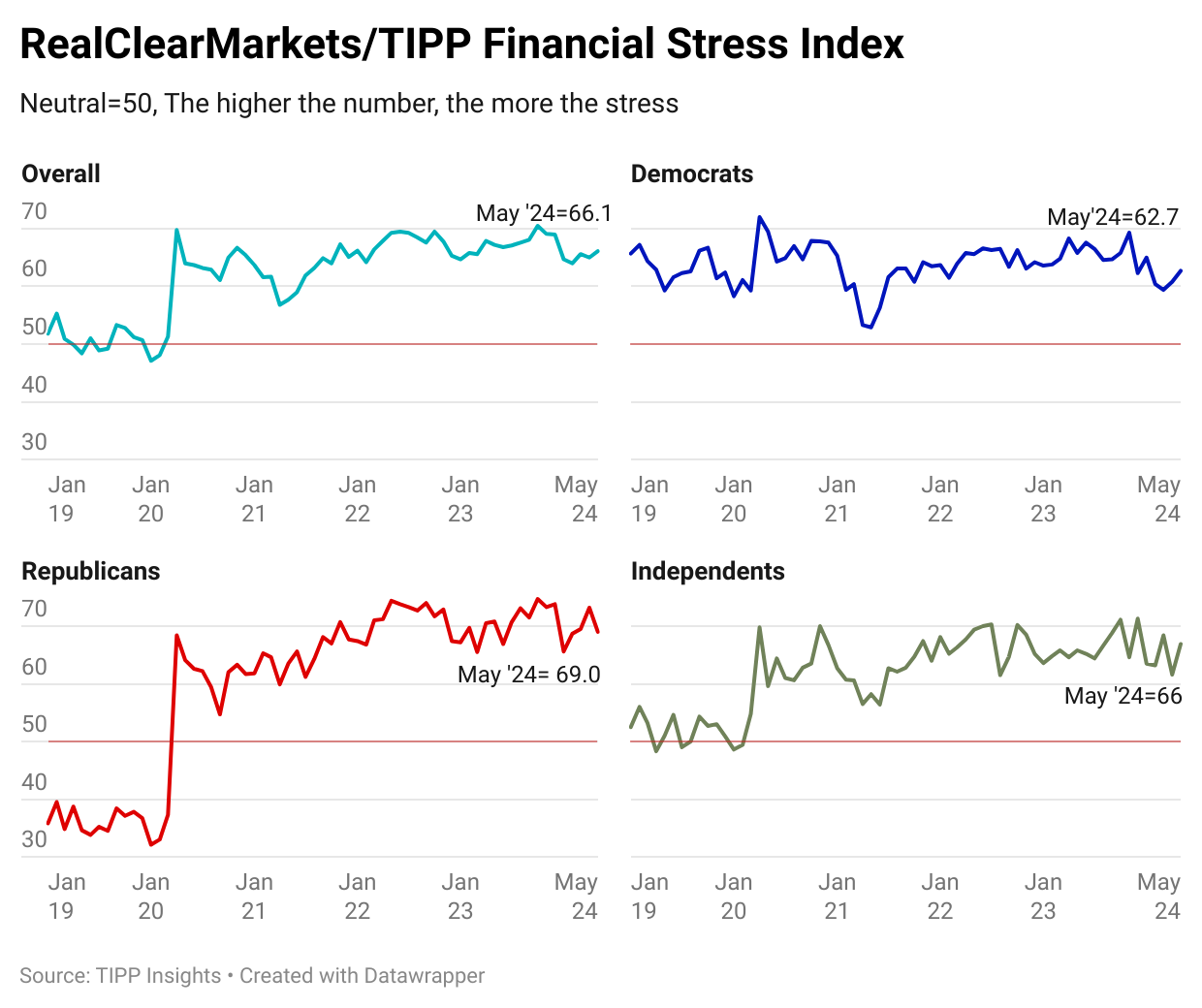
By The Numbers
The table below shows the index's historical averages, the May readings, and the differences across demographic groups. All 35 demographic groups exhibit stress, with readings above the neutral level of 50.0. Of the 35 demographic categories, 14 (40%) experience stress, 10% higher than their historical average.
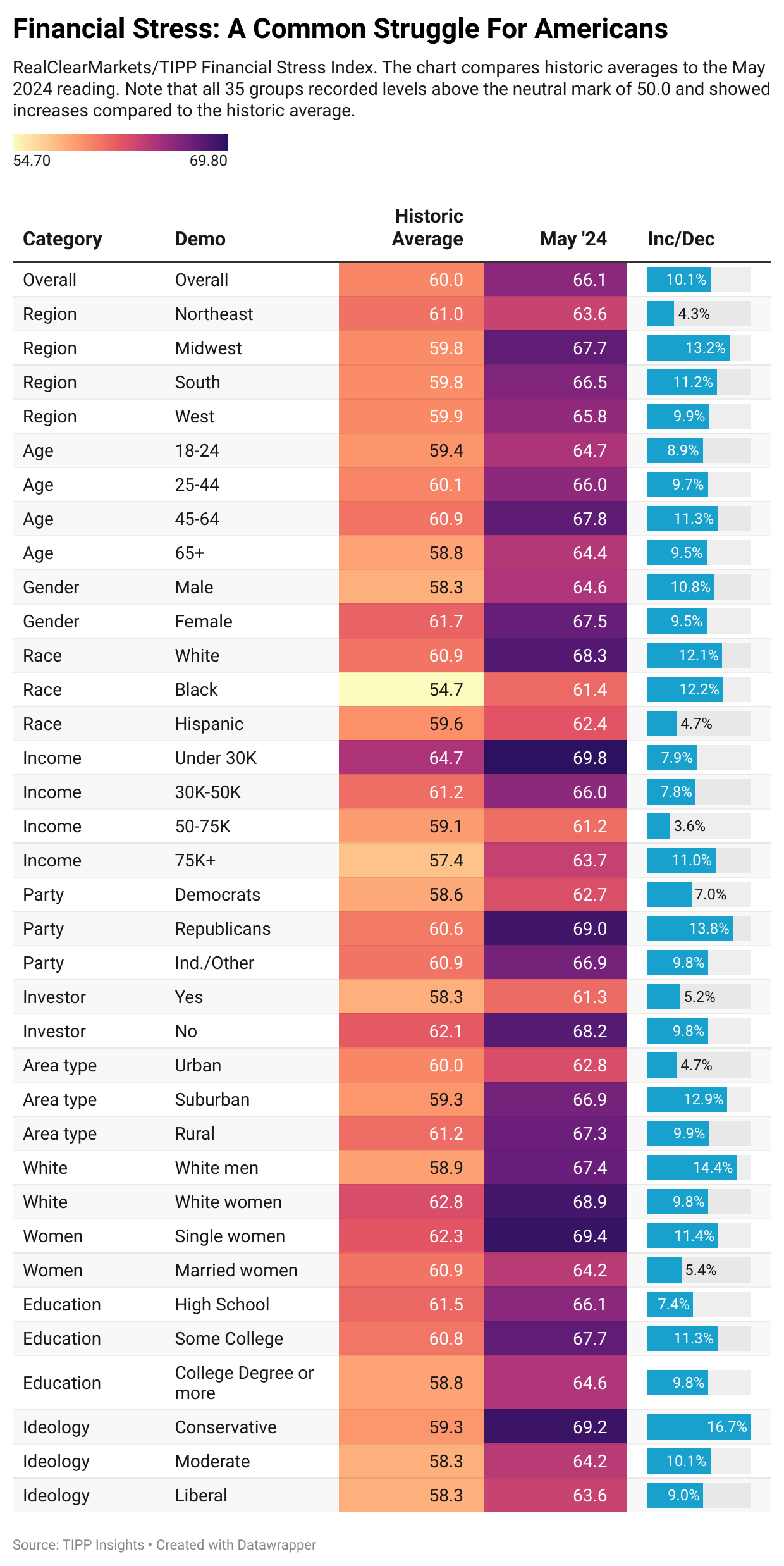
Here are the ten demographic groups with the highest stress levels based on the average of five months of 2024. Conservatives, Republicans, and under $30K households are the most stressed group, followed by white women.
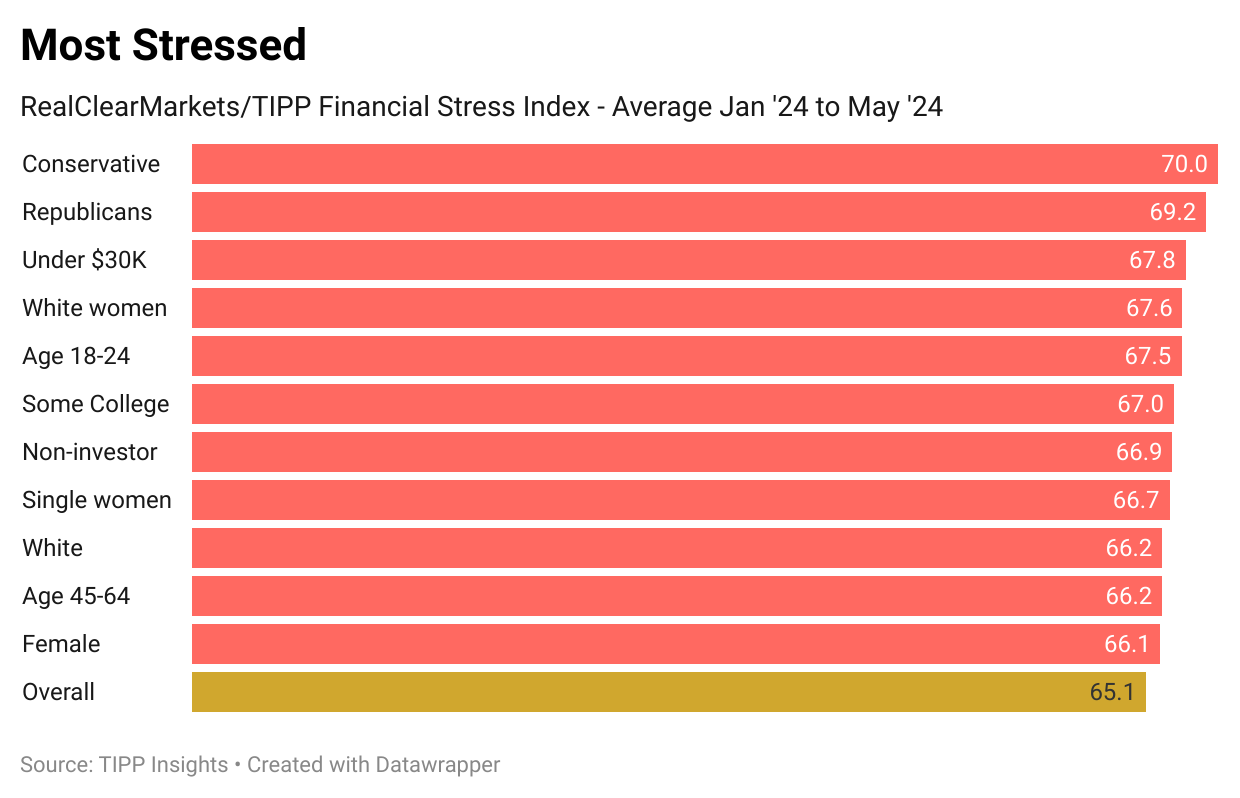
The chart below shows the ten demographic groups with the least stress based on the average for the first five months of 2024. The groups experiencing the least stress are males, households with an income of $75K or more, individuals with a college degree or higher, moderates, households in the $50K-$75K income bracket, those in the 65+ age bracket, Democrats, Blacks, investors, and liberals.

Cause Of Stress
Most Americans are stressed because their wages have not kept pace with price increases. According to Moody’s, the typical American household now requires $1,069 more each month (equivalent to $12,828 annually) compared to three years ago.
Under President Biden, real wages have declined by 2.6%. According to the government data, average hourly earnings for all employees dropped 2.6% to $11.09 in April 2024 from $11.39 in January 2021 when Biden took office. Nominal wages represent the amount of money one earns without considering changes in the cost of living. On the other hand, real wages consider inflation and measure the purchasing power of wages.
In the latest TIPP Poll completed in early May, only 18% of Americans say their earnings have kept pace with inflation.
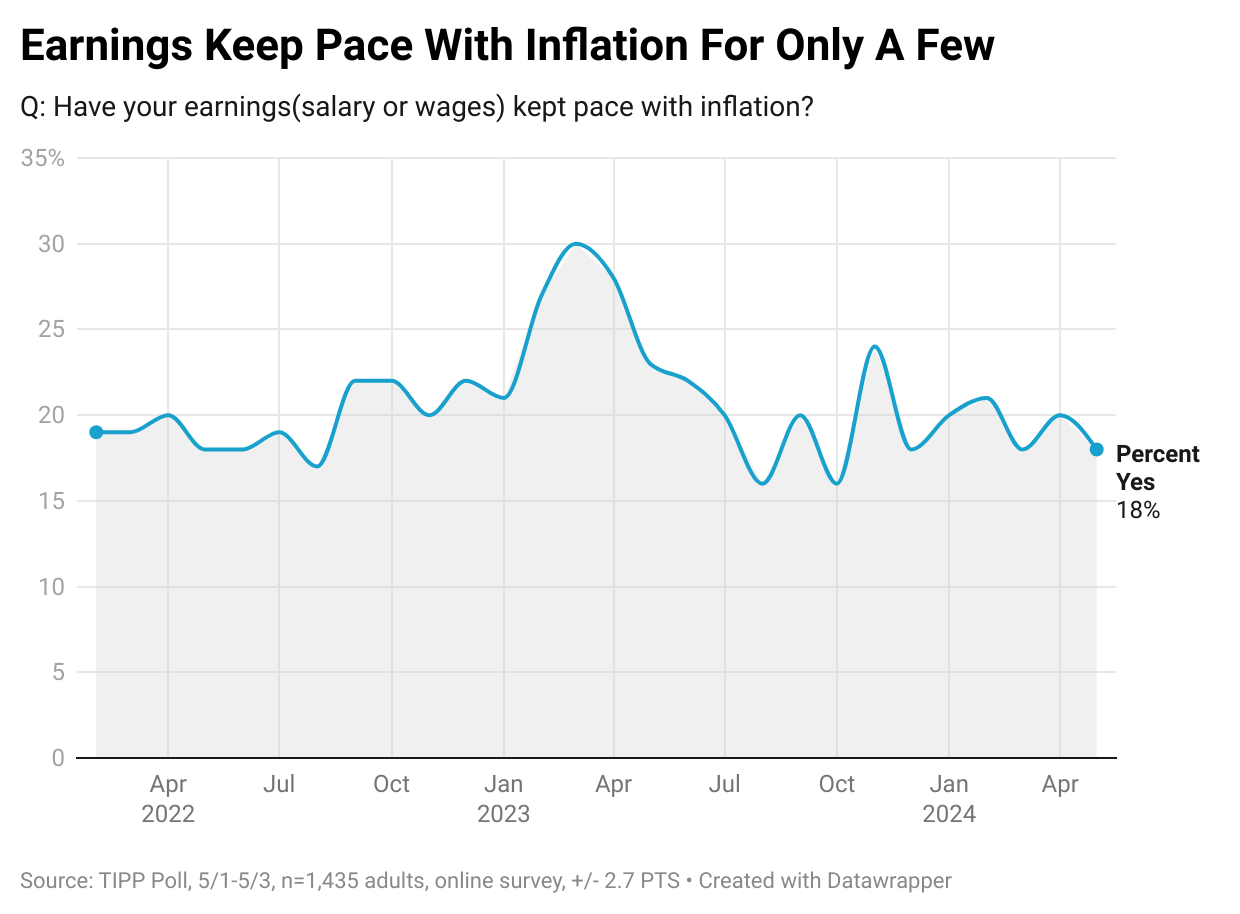
Financial Hardships Hit Lower-Income Households Hardest
In the current economy, Americans struggle to make ends meet. The chart below describes their struggles. It shows that more households in the lower income bracket are facing hardships than higher-income households. For example, 69% of households under $ 30K income are concerned about paying their utility bills compared to 60% for $30K-$50K, 53% for $50K-$75K, and 41% for $75K.

Diverse Strategies To Manage Higher Food Costs
Americans are struggling to adjust to higher food costs. The chart below reveals some shocking statistics.
- 31% are eating less
- 23% are skipping meals
- 21% go to food banks to supplement groceries
- 19% have applied for federal or state assistance
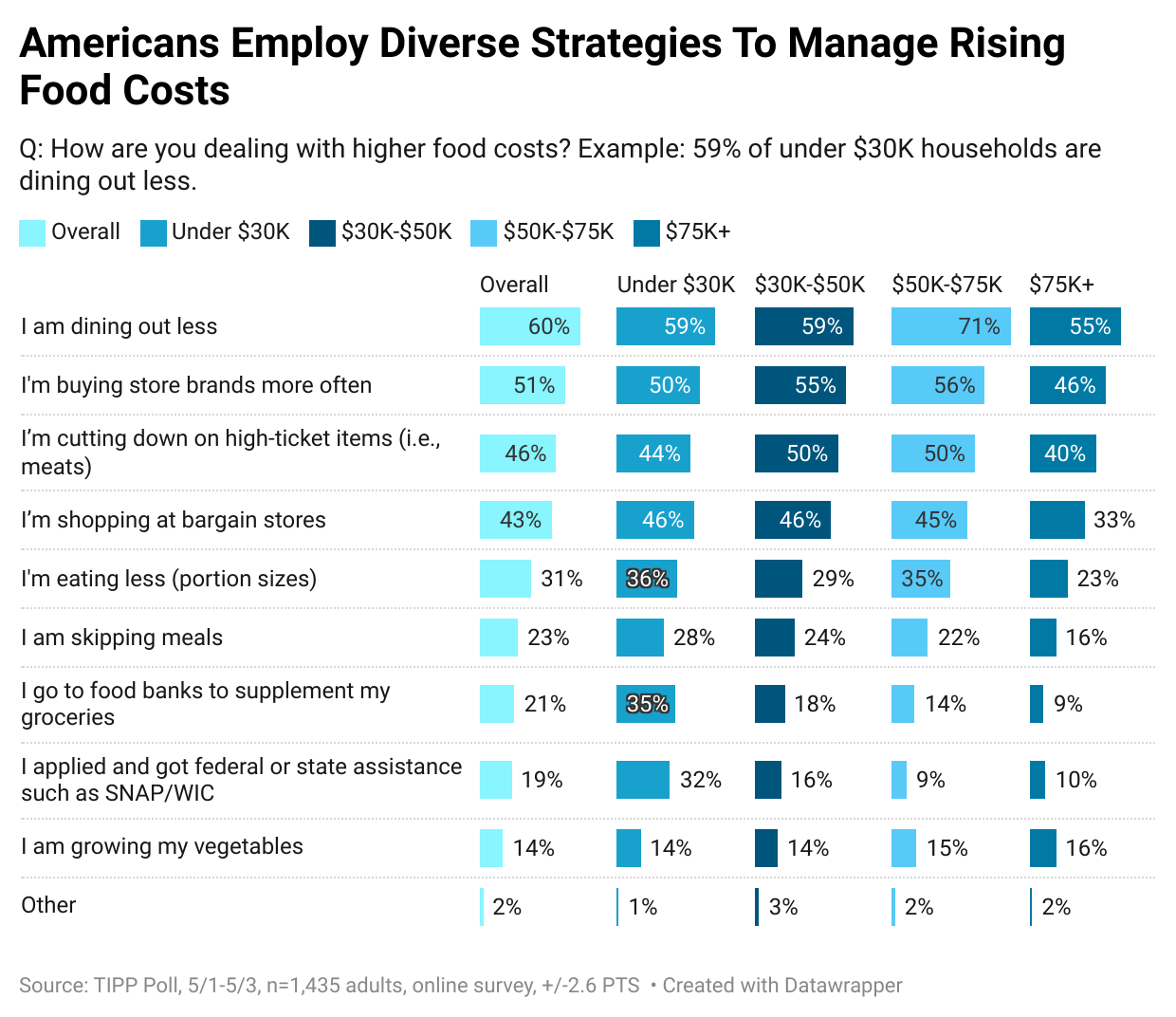
Biden’s Handling Of The Economy
In the latest TIPP poll taken in early May, most Americans (51%) give Biden a failing grade (D or F) regarding his handling of the economy. Only 27% give him an A or B.
Among Democrats, half (52%) give him positive grades, 19% believe he deserves failing grades, and another 25% rate his performance as average (C).
In contrast, Republicans are much more critical, with 81% expressing dissatisfaction with Biden's handling of the economy.
Furthermore, independents also express their disappointment, with 57% giving failing grades, 18% giving good grades, and 21% rating Biden’s performance as average.

Current record stress levels are a consequence of Bidenomics. The recent GDP and manufacturing data reflect that the economy will likely slow down. Combined with unyielding inflation powered by Biden’s wasteful spending, inflation will likely persist for the foreseeable future. Americans must brace for an extended period of stagflation. We don’t enjoy being the bearers of bad news. However, we would rather not sugarcoat the situation or find scapegoats.
If you are interested in what President Biden's economic advisor has to say, watch this video.
Like our insights? Show your support by becoming a paid subscriber!








